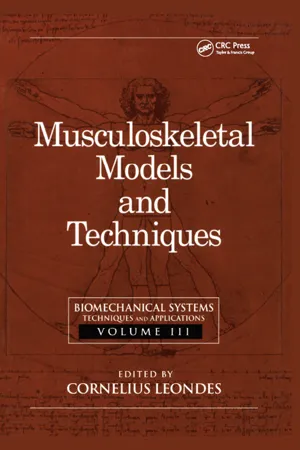
Biomechanical Systems
Techniques and Applications, Volume III: Musculoskeletal Models and Techniques
Cornelius T. Leondes, Cornelius T. Leondes
- 224 pagine
- English
- ePUB (disponibile sull'app)
- Disponibile su iOS e Android
Biomechanical Systems
Techniques and Applications, Volume III: Musculoskeletal Models and Techniques
Cornelius T. Leondes, Cornelius T. Leondes
Informazioni sul libro
Because of developments in powerful computer technology, computational techniques, advances in a wide spectrum of diverse technologies, and other advances coupled with cross disciplinary pursuits between technology and its greatly significant applied implications in human body processes, the field of biomechanics is evolving as a broadly significant area. This Third Volume presents the advances in widely diverse areas with significant implications for human betterment that occur continuously at a high rate. These include dynamics of musculo-skeletal systems; mechanics of hard and soft tissues; mechanics of muscle; mechanics of bone remodeling; mechanics of implant-tissue interfaces; cardiovascular and respiratory biomechanics; mechanics of blood flow, air flow, flow-prosthesis interfaces; mechanics of impact; dynamics of man machine interaction; and numerous other areas. The great breadth and depth of the field of biomechanics on the international scene requires at least four volumes for adequate treatment. These four volumes constitute a well integrated set that can be utilized as individual volumes. They provide a substantively significant and rather comprehensive, in-depth treatment of biomechanic systems and techniques that is most surely unique on the international scene.
Domande frequenti
Informazioni
Indice dei contenuti
- Cover
- Title Page
- Copyright Page
- Table of Contents
- 1 Three-Dimensional Dynamic Anatomical Modeling of the Human Knee Joint
- 2 Techniques and Applications of Adaptive Bone Remodeling Concepts
- 3 Techniques in the Dynamic Modeling of Human Joints with a Special Application to the Human Knee
- 4 Techniques and Applications of Scanning Acoustic Microscopy in Bone Remodeling Studies
- 5 Techniques and Applications for Strain Measurements of Skeletal Muscle
- 6 A Review of the Technologies and Methodologies Used to Quantify Muscle-Tendon Structure and Function
- 7 A Technique for the Measurement of Tension in Small Ligaments
- Index